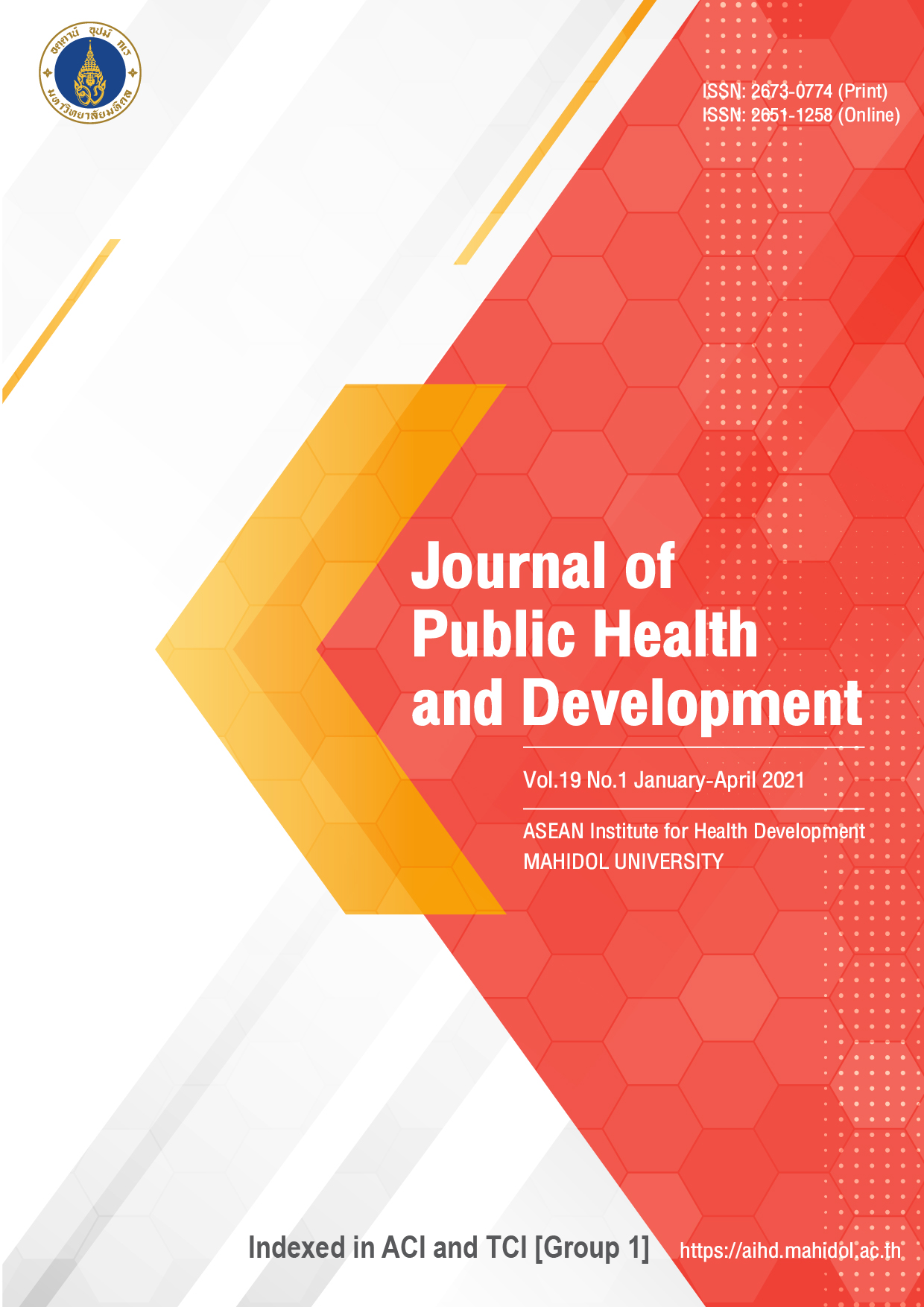Effects of job design and Generation Y nurse relations on Generation Y nurses, performance at tertiary level hospitals under the ministry of public health
Main Article Content
Abstract
This predictive research was to analyze the effects and predict the job design and Generation Y nurses relations on Generation Y nurses’ performance at tertiary level hospitals under the Ministry of Public Health. The researcher developed the concept of job design and Generation Y nurses relations from the Human Resource Management Practice Model (HRMP) of Noe, et al.1 and adapted the concept of Task and Contextual Performance for Nurses: Job Performance Scale of Greenslade & Jimmieson.2 The sample was 429 Generation Y nurses assigned to in-patient wards. The instruments consisted of 1) job design 2) Generation Y nurse relations and 3) Generation Y nurses’ performance with five Likert scales. Five experts rated content validity with scores equal to 0.91, 0.93 and 0.95, respectively. The Confirmatory Factor Analysis showed that each model was congruent with the empirical data (CMIN/DF = 1.33, 1.25, 1.11, GFI =.97, .92, .99, RMSEA = .03, .02, .02, respectively). The data were analyzed by using descriptive and inferential statistics, which included independent t-test, Pearson’s correlation coefficient and multiple regression analysis. The results revealed that job design, Generation Y nurse relations and Generation Y nurses’ performance were at a high level (x̄ = 4.29, SD=36, x̄ = 3.91, SD=.48 and x̄ = 4.14, SD=.43, respectively). Generation Y nurses with different work experience had statistically significant differences in job design, Generation Y nurse relations and Generation Y nurses’ performance (p<.001). Job design and Generation Y nurses’ relations positively affected Generation Y nurses’ performance at β = .463 and β = .334, p < .001 and p < .001, respectively, which accounted for 51.50% (R2 = .515). Therefore, nurse administrators should facilitate study visits both inside and outside hospitals, provide adequate place importance on contextual roles and determine nursing policy on volunteering for additional duties.
Article Details
References
Noe RA., Hollenbeck J R, Gerhart B and Wright PM. Fundamentals of Human Resource Management. New York: acid-free paper; 2016.
Greenslade JH and Jimmieson NL. Distinguishing between task and contextual performance for nurses: Development of a job performance scale. JAN. 2007; 58(6): 602- 611.
Sen, C. & Dulara, S. Job Characteristic and Performance: The Mediating Role of Job Crafting. IJIP. 2017; 5(1): 66-74.
Som, R.M., Mustapha, R. M. R., Othman, A.K., Aziz, R.A. & Noranee, S. Exploratory Factor Analysis: Conceptualization, Reliability and Validity of Job Performance. IJSSH. 2015; 5(5): 440-445.
Sritoomma N. Service excellence: Strategies for Healthcare and Nursing Services. Indian J Public Health Res Dev. 2018; 9 (10): 521-526.
Mason, T.A., Sibiya, M.N., & Nkosi, Z.Z. (2020). Mixed Methods Develop-ment of a Leadership Framework for Generation Y Bedside Nurses. Glob J Health Sci. 2010; 12(1): 125-138.
Sawangdee K. An In-depth View of the Health System – Thailand’s Nurse Shortage [Internet]. 2018 [cited 2016 July]. Available from: https://www. hfocus.org/content/2016/03/11933.
Division of Strategy and Planning, Ministry of Public Health. Public Health Personnel Information Report of 2018 [Internet]. 2018[cited 2019 January 8]. Available from: http://bps. moph.go.th.
Lamounpuk, S, Supparerkchaisakul, N & Srisatidnarakul, B. Multilevel Antecedents of Professional Engage-ment, Job Performance and Intention to Leave the Nursing Profession, among Governmental Hospital Registered Nurses in the Bangkok Metropolitan. JBS. 2015; 21(2): 78-100.
Suparasri P, Sritoomma N, Luanga-monlert S. Development of Job Design Indicators for Generation Y Nurses at Tertiary Level Hospitals under the Ministry of Public Health in Thailand. Indian J Public Health Res Dev. 2020; 11(3): 693-698.
Yuxiu, P., Kanaviktikul, W. & Thungjaroenkul, P. Job Characteristic and Job Performance among Professional Nurses in the University Hospitals of People’s Republic of China. CMU. J. Nat Sci. 2011; 10(2): 171-180.
Loice M, Geoffrey B and Nehemiah C. Selected Job Characteristics and Performance of Nursing Employees in Nation Referral Hospitals in Kenya. EJBM. 2013; 5(17): 2222-2839.
Ali N and Zai-ur-Rehman M. Impact of Job Design on Employee Performance, Mediating Role of Job Satisfaction: A Study of FMCG’s Sector in Pakistan. IJBM. 2014; 9 (2): 70-79.
Faroog SU, Sharms MS amd Niazi MM. (2015). Factor Affecting Employees’ performance: A case of Kabul-Based Telecom Firms. B&ER. 2015; 7(2): 71-84.
Omuya JM. The Influence of employee relations on employee performance in public Universities in Kenya. IJECM and 20 Management 2018; VI (3): 280-310.
Jamieson I, Kirk R, Wright S and Andrew C. Generation Y New Zealand Registered Nurses’ views about nursing work: a survey of motivation and maintenance factors. The Open Nursing Journal; John Wiley & Sons Ltd. 2015; 49-61.
Krejcie RV, Morgan DW. Determining sample size for research activities, 1970.
DeVellis RF. Scale development: Theory and Applications. 4th ed. Singapore: SAGE Publication, Inc; 2016.
Best, J.W. & Kahn, J.V. (2014). Research in Education [Internet]. 8th ed. New York: Allyn and Bacon. Available from: http://ww2.odu.edu/ ~jritz/attachments/reined.pdf.
Benner P. Form novice to expert: Excellence and power in clinical nursing practice. Menlo Park, CA: Addison-Wesley; 1984.
Pinthong, P. & Thaweepaiboonwong, J. The influence of Human Resource Management on intension to stay of Generation Y engineer employees at industrial estate in Rayong, Suthiparithat 2018; 32(103) :174-188.
Kuzu OH, Ozilhan D. The Effect of Employee Relationships and Knowledge Sharing on Employees’ Performance: An Empirical Research on Service Industry. Procedia Soc Behav Sci. 2014:1370 – 1374.


